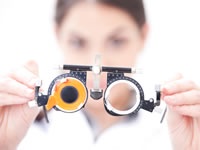Automated screening systems for the early detection of diabetic retinopathy: a disease commonly resulting in blindness in adults

Diabetic retinopathy occurs when high blood sugar levels damage the cells at the back of the eye. It is a serious complication of diabetes and is the leading cause of loss of eyesight in the western world in individuals of working age. Screening programmes are essential to detect disease at an early stage. Research in Aberdeen demonstrated that, by introducing digital cameras into screening programmes, only one image of each eye was required without the need for dilation of the pupil. This change improved the patient experience.
Researchers also designed and validated software that identifies images showing early disease. The software reduced costs and the workload of manual screeners. The software increases the effectiveness of manual screening by acting as an extra level of quality assurance. Since the original design, developers further extended the software so that it can also detect macular oedema with a high specificity. The group showed that the addition of a digital imaging technology called Optical Coherence Tomography (a medical imaging technique which uses light to capture three-dimensional images from tissue) has the potential to further reduce costs to the health service.
This is a good example of academic research having a beneficial impact on the NHS. Our system enables NHS professionals to provide an efficient, high quality service to patients with diabetes
Professor Peter Sharp
Find out more
Key publications
- Spencer T, Phillips RP, Sharp PF and Forrester JV. Automated detection and quantification of microaneurysms in fluorescein angiograms. Graefe's Archive for Clinical and Experimental Ophthalmology 1992; 230, 90-94. One of the earliest descriptions of a technique for detecting microaneurysms but used fluorescein angiogram images.
- Cree MJ, Olson JA, McHardy KC, Sharp PF, Forrester JV. A fully automated comparative microaneurysm digital detection system. Eye 1997; 11, 622-628. This paper addressed, for the first time, the more difficult task of detecting microaneurysms in fundus camera images in a fully automated way.
